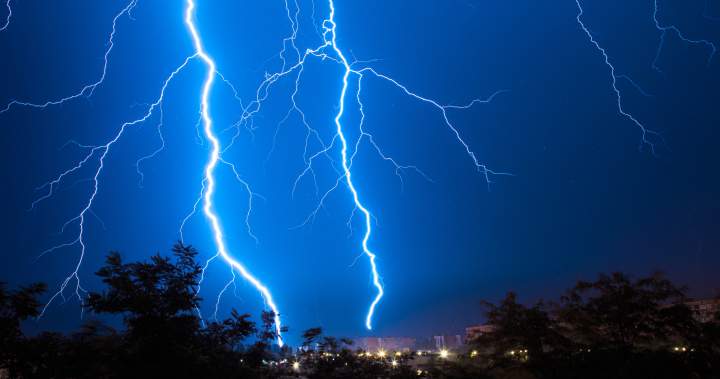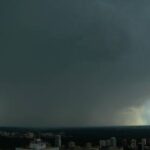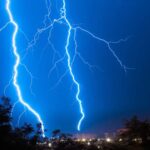A sudden summer storm turned dangerous for an Edmonton woman who was struck by lightning while walking her dog in the Greenfield neighbourhood Monday afternoon, marking the city’s first reported lightning injury this season.
The 32-year-old woman was hit around 4:30 p.m. near 114 Street and 40 Avenue as severe thunderstorms swept through the region. Witnesses reported hearing a deafening crack before seeing the woman collapse to the ground, her small terrier running in circles nearby.
“I heard what sounded like an explosion and looked out my window to see someone down on the sidewalk,” said James Moretti, a local resident who called emergency services. “The sky had darkened so quickly, and then this bolt just came out of nowhere. It was terrifying.”
First responders arrived within minutes and found the victim conscious but disoriented. According to Edmonton Emergency Medical Services, she suffered moderate burns to her left shoulder and arm, along with temporary hearing loss. She was transported to the University of Alberta Hospital where she remains in stable condition.
Environment Canada meteorologist Danielle Desjardins confirmed that the storm cell that passed through Edmonton produced over 200 lightning strikes within a 30-minute period. “This particular system developed rapidly, giving people little time to seek shelter,” Desjardins explained. “We recorded wind gusts up to 70 km/h and intense electrical activity throughout the metropolitan area.”
The incident has prompted Edmonton’s emergency management officials to remind residents about lightning safety protocols. “When thunder roars, go indoors,” said Fire Chief Kenneth Letourneau. “Lightning can strike up to 10 kilometers away from rainfall, so clear skies overhead don’t necessarily mean you’re safe.”
Statistics from Environment Canada show that lightning strikes kill approximately two to three Canadians annually and injure 80 to 90 others. Alberta, with its open prairies and summer storm patterns, consistently ranks among the provinces with the highest lightning density.
Dr. Elena Mikhailov, trauma specialist at the University of Alberta Hospital, noted that lightning injuries can vary widely in severity. “The electrical current from lightning can cause cardiac arrest, neurological damage, or burns. This patient was fortunate that the strike appears to have been a side flash rather than a direct hit, which likely spared her from more serious injuries.”
The woman’s dog, a three-year-old Jack Russell terrier, was unharmed in the incident. A family member has since collected the pet while the owner continues her recovery.
As summer thunderstorm season intensifies across Canada, meteorologists urge residents to monitor weather forecasts carefully and have emergency plans in place. The CO24 Weather team forecasts additional storms for the Edmonton region through Wednesday, with conditions gradually stabilizing by week’s end.
This incident raises important questions about urban lightning safety: with increasingly unpredictable weather patterns due to climate change, should cities invest more in lightning-safe infrastructure and early warning systems to protect residents in an era of more frequent and intense storms?























